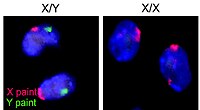
Back نظام تحديد الجنس ZW Arabic ZW sistem determinacije spola BS Sistema de determinació del sexe ZW Catalan Z-Chromosom German Σύστημα προσδιορισμού φύλου ZW Greek Sistema ZW de determinación del sexo Spanish روش گزینش جنسی ZW Persian Système ZW de détermination sexuelle French Determinación do sexo ZW Galician Ivart meghatározó ZW rendszer Hungarian

| Part of a series on |
| Sex |
|---|
 |
| Biological terms |
| Sexual reproduction |
| Sexuality |
| Sexual system |
The ZW sex-determination system is a chromosomal system that determines the sex of offspring in birds, some fish and crustaceans such as the giant river prawn, some insects (including butterflies and moths), the schistosome family of flatworms, and some reptiles, e.g. majority of snakes, lacertid lizards and monitors, including Komodo dragons. It is also present in some plants, where it has probably evolved independently on several occasions.[1] The letters Z and W are used to distinguish this system from the XY sex-determination system. In the ZW system, females have a pair of dissimilar ZW chromosomes, and males have two similar ZZ chromosomes.
In contrast to the XY sex-determination system and the X0 sex-determination system, where the sperm determines the sex, in the ZW system, the ovum determines the sex of the offspring. Males are the homogametic sex (ZZ), while females are the heterogametic sex (ZW). The Z chromosome is larger and has more genes, similarly to the X chromosome in the XY system.
- ^ Zhou, Ran; Macaya-Sanz, David; Carlson, Craig H.; thirteen others, and (14 February 2020). "A willow sex chromosome reveals convergent evolution of complex palindromic repeats". Genome Biology. 21 (1): 38. doi:10.1186/s13059-020-1952-4. PMC 7023750. PMID 32059685.